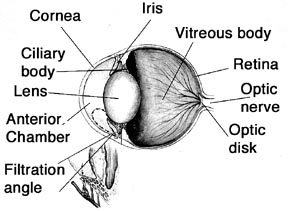Call me a hypochondriac. Its an occupational hazard for the official cat in the Cornell Feline Health Center, surrounded as I am by the College of Veterinary Medicine and all this medical talk.
Call me old. I am 12, and in cat years, that puts me in the physiologic age bracket when many humans develop cataracts in their eyes.
Or call me curious, which is much more flattering. Could it be that the old Mewser has cataracts – cloudiness in the lenses of the eyes that starts as small spots and grows to cause blindness. If so, what to do?
So I checked in to the Cornell University Hospital for Animals, where Id heard they have a new machine to remove cataracts with the scary-sounding procedure called phacoemulsification, and the eye doctor there gave me good news. And even better news.
No you dont have cataracts, Audrey Yu-Speight, DVM, a resident in ophthalmology reported after a brief examination of my eyes. Yes, cataract surgery is successful in 90 percent of the cases, she added, leaning on a machine called the phacoemulsifier. Okay, if I can read fine print on medical devices, my vision must be pretty good. But what about those that have their cataracts removed by this gizmo – will they need reading glasses?
Cats Arent People
Hold on, youre confusing people problems with feline problems, Yu-Speight said, and she told me what kind of cats get cataracts. It has little to do with age, old or otherwise, she noted. First, cataracts are quite rare in cats, compared to humans or even to dogs. The causes, among cats, are internal eye inflammation (uveitis) that resulted from systemic disease elsewhere in the body, heredity, or traumatic injury to the eye. Hereditary cataracts in cats show up almost immediately in young kittens, so if you havent had them by now, chances are you wont ever, Yu-Speight said reassuringly. And as for ocular insults from injuries, Ill stay out of fights and keep driving safely. (Remember Toonces, the cat who could drive a car, from the Saturday Night Live shows on NBC from 1988 to 1993? Toonces blamed his lousy driving on a brain injury, sustained as a stunt man on The Dukes of Hazzard, but Ill bet he just had cataracts.)

288
Whatever the cause, blind is blind, and a cats quality of life usually improves when the cataracts are surgically removed, Yu-Speight said. Before she cranks up that phacoemulsifier, though, some preliminary tests are in order. Blood tests check for other conditions that would make a poor candidate for surgery, and two kinds of imaging exams gauge the health of the retina behind the lens: A sonogram ensures that the patient doesnt have a detached retina and a retinogram (a close-up flash photo of the eye) also checks the health of that part. Without a good, working retina, cataract surgery wont help at all, Yu-Speight said.
Cleared for takeoff, a cataract surgery patient gets antibiotics and general anesthesia at the start of the procedure. Yes, I know human patients sometimes manage with local anesthetic, but we cats are so fidgety when you start poking around in our eyes that its better if we sleep through the process.
And there is some poking involved. First, the surgeon makes an incision through the cornea, which covers the eye, and then through the membrane that surrounds the lens. In medical lingo, the surgeon is opening the bag, but I prefer the more elegant term, the lens capsule because through that incision they will insert a high-tech, powerful device.
Phacoemulsification
The probe from the phacoemulsifier is a hollow needle-like affair with a rotating and vibrating tip. Very high frequency vibrational energy, generated from the machine and transmitted through the probe, causes whatever it touches to break apart into tiny pieces – to become emulsified. And whats left of the cloudy, useless lens is sucked out through the hollow probe – or aspirated, if you prefer the polite term.
Speaking of terminology, human cataract patients may say they had laser surgery, but they didnt. Humans and pets all get phacoemulsified – same kind of machine, same procedure, although what comes out of that hollow probe may be a little different. Yu-Speight says the remains from a cats or dogs cataract sometimes looks like little bits of shattered glass. Thats because the cataract-afflicted lens was almost as hard as glass, in part because veterinary surgeons usually let the cataract develop more fully before operating, while humans get surgery soon after the cataract develops.
Ophthalmic surgeons operate while looking through a sophisticated, high-powered microscope that comes down from the ceiling. Compared to the $500,000 cost of the microscope, the price for a phacoemulsifier is a mere $80,000 or so. Now you start to understand why this procedure is offered exclusively by highly trained specialists at veterinary college hospitals and a few veterinary vision centers around the country. Charges are around $2,000 per eye, and if both eyes have cataracts, surgeons often do both in one session.
E Is for Elizabethan
One souvenir humans dont take home is the dreaded Elizabethan collar, or E-collar. Cats (and dogs, too) cant be trusted not to rub their recovering eyes, so the veterinary surgeons fit that big, stiff collar for our own protection. We also get antibiotics, both orally and topically (in the eye, in the form of drops or ointment) to prevent infection and reduce swelling.

180
Glaucoma (high pressure in the eye) and uveitis are possible complications after surgery, Yu-Speight said. Theres also a remote chance of a detached retina after surgery and an even smaller chance that a bit of the lens was left behind and will grow back – but not into a perfectly functional lens this time. (That only happens in young animals, but when it does, surgeons go back in and remove the regrown lens.) The recovering patient experiences very little pain, Yu-Speight said, just a little irritation in the surface of the eye from the sutures and temporary sensitivity to bright light. Cats can go home about three days after surgery, ready to be laughed at with that darn Elizabethan collar.
Some, however, take home an extra goodie – an artificial lens made of acrylic plastic that is implanted in place of the emulsified one before the incisions are closed. The new lens is optional at the discretion of the human companion and advice of the veterinarian, because we can easily live without it. Taking away the natural lens leaves us farsighted, Yu-Speight explained. We can see pretty well at distances – once that cloudy cataract is out of the way – but well never read a phone book again.
Close vision is a luxury most pets dont need, the specialist said, because the restoration of any vision produces such a dramatic improvement in quality of life. Cats can see the furniture again instead of bumping into it, and they can see the toys theyre playing with, according to Yu-Speight. Another consideration is that our bodies regard that plastic lens as a foreign body so lens recipients need daily medication every day for the rest of our lives. True, a spiffy new lens gives a cat something to brag about around the feeding bowl. But even without one, at least he can find the bowl again.
We like to see the cataract surgery patient for a check-up after a year, Yu-Speight said. Ninety out of 100 patients recover so well, she promised, that they could find their way back to the hospital on their own.



